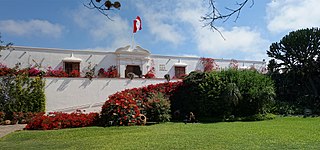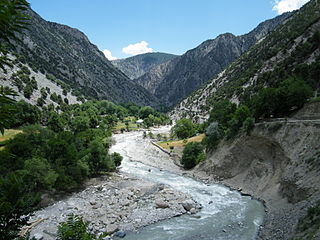
Chitral is a city situated on the Chitral River in northern area of Khyber Pakhtunkhwa. It serves as the capital of the Lower Chitral District, and was previously the capital of Chitral District, and before that the capital of Chitral princely state. The region was encompassed into West Pakistan between the years 1969 and 1972. It has a population of 49,780 per the 2017 census.

Saidū Sharīf is the capital of the Swat district, Khyber Pakhtunkhwa, Pakistan. The city also serves as the capital of the Malakand Division. It was named after Saidu Baba, a prominent leader of the former state of Swat.

The Peshawar Museum is a museum located in Peshawar, capital of Pakistan's Khyber Pakhtunkhwa province. The Peshawar Museum is notable for its collection of Buddhist artwork dating from the ancient Gandhara region.

The National Museum of Indonesia is an archeological, historical, ethnological, and geographical museum located in Jalan Medan Merdeka Barat, Central Jakarta, right on the west side of Merdeka Square. Popularly known as the Elephant Museum after the elephant statue in its forecourt, its broad collections cover all of Indonesia's territory and almost all of its history. The museum has endeavoured to preserve Indonesia's heritage for two centuries.

The Larco Museum is a privately owned museum of pre-Columbian art, located in the Pueblo Libre District of Lima, Peru. The museum is housed in an 18th-century vice-royal building. It showcases chronological galleries that provide a thorough overview of 5,000 years of Peruvian pre-Columbian history. It is well known for its gallery of pre-Columbian erotic pottery.

The Kho or Chitrali people, are an Indo-Aryan ethnolinguistic group native to the Chitral District in Khyber Pakhtunkhwa and the Gupis-Yasin and Ghizer districts in Gilgit-Baltistan of Pakistan. They speak an Indo-Aryan language called Khowar.

The Kalasha, or Kalash, are an Indo-Aryan indigenous people residing in the Chitral District of the Khyber-Pakhtunkhwa province of Pakistan.

Bumburet is the largest valley of Kalasha Desh in Lower Chitral District, Khyber Pakhtunkhwa the province of Pakistan.
The Brigham Young University Museum of Peoples and Cultures, located in Provo, Utah, is the university's museum of archaeology and ethnology. The Museum of Peoples and Cultures has a wide variety of collections containing over a million objects. Most of the 7,000 collections come from the regions of South America, Mesoamerica, Central America, the American Southwest, the Great Basin and Polynesia. However, there are many objects from other parts of the world which are available for study and research.

Rumbur is one of the three Kalasha valleys situated in Lower Chitral District, Khyber Pakhtunkhwa, Pakistan.
Kunal is a pre-Harappan Indus Valley civilisation settlement located, just 30 km from Fatehabad City in Fatehabad district of Haryana state in India. Compared to other IVC sites, such as cities like Rakhigarhi and towns like Kalibangan, Kunal site was a village. Excavation at Kunal show 3 successive phases of Pre-Harappan indigenous culture on the Saraswati river who also traded with Kalibanga and Lothal. Kunal, along with its other contemporary sites Bhirrana and Rakhigarhi on Sarasvati-Ghaggar river system, is recognised as the oldest Pre-Harappan settlement, with Kunal being an older cultural ancestor to Rehman Dheri in Pakistan< which is on the Tentative List for future World Heritage Sites.

The traditional clothing and accessories worn in Khyber Pakhtunkhwa varies according to the area of the region. The following outfits are generally worn in the area, starting to north to south:

Swat Museum is a museum located in Mingora, on the road connecting Mingora and Saidu Sharif in the Swat District of the Khyber Pakhtunkhwa province of Pakistan.
Chilam Joshi Festival is a festival celebrated by the Kalash people, living in the Chitral District of Khyber Pakhtunkhwa province in Pakistan. It marks the commencement of spring within the Kalasha community and is celebrated from the 13th to the 16th of May each year.
Dir Museum, also known as Chakdara Museum, is located in Chakdara, Lower Dir District, in the Khyber Pakhtunkhwa province of Pakistan. The museum offers a fine and unique collection of Gandharan Art.
Bannu Museum is a museum located in Bannu District, Khyber Pakhtunkhwa, Pakistan. The museum was established by the Directorate of Archaeology and Museums, Khyber Pakhtunkhwa and inaugurated in 2011 by Sayed Aqil Shah, Minister for Sports, Tourism, Archaeology, and Youth Affairs.
Mardan Museum is located in the Mardan District, Khyber Pakhtunkhwa, Pakistan. The museum was first established in 1991 in a Town Hall with a single hall with 22 show cases displaying more than 90 Gandhara's sculptures by the supervision of Sahibzada Riaz Noor. Later in 2006 a portion of land provided by the Mardan District Government on the request of Provincial Government and build three Galleries which was inaugurated by a former Chief Minister of Khyber Pakhtunkhwa Ameer Haider Khan Hoti in 2009.
City Museum is an archaeology museum located on the archaeological site of Gorkhatri, Peshawar in the Khyber Pakhtunkhwa province of Pakistan. The museum was inaugurated on 23 March 2006 by Akram Khan Durrani, the then Chief Minister of Khyber Pakhtunkhwa.

Kalasha Dur Museum, also known as Bumburet Museum, is a museum located in Bumburet Valley, Lower Chitral District in the Khyber Pakhtunkhwa province of Pakistan. The museum houses a collection related to the culture and history of the Kalash people, as well as of the communities of the wider Hindu Kush area.

Lower Chitral District is a district in Malakand Division of Khyber Pakhtunkhwa province in Pakistan.














